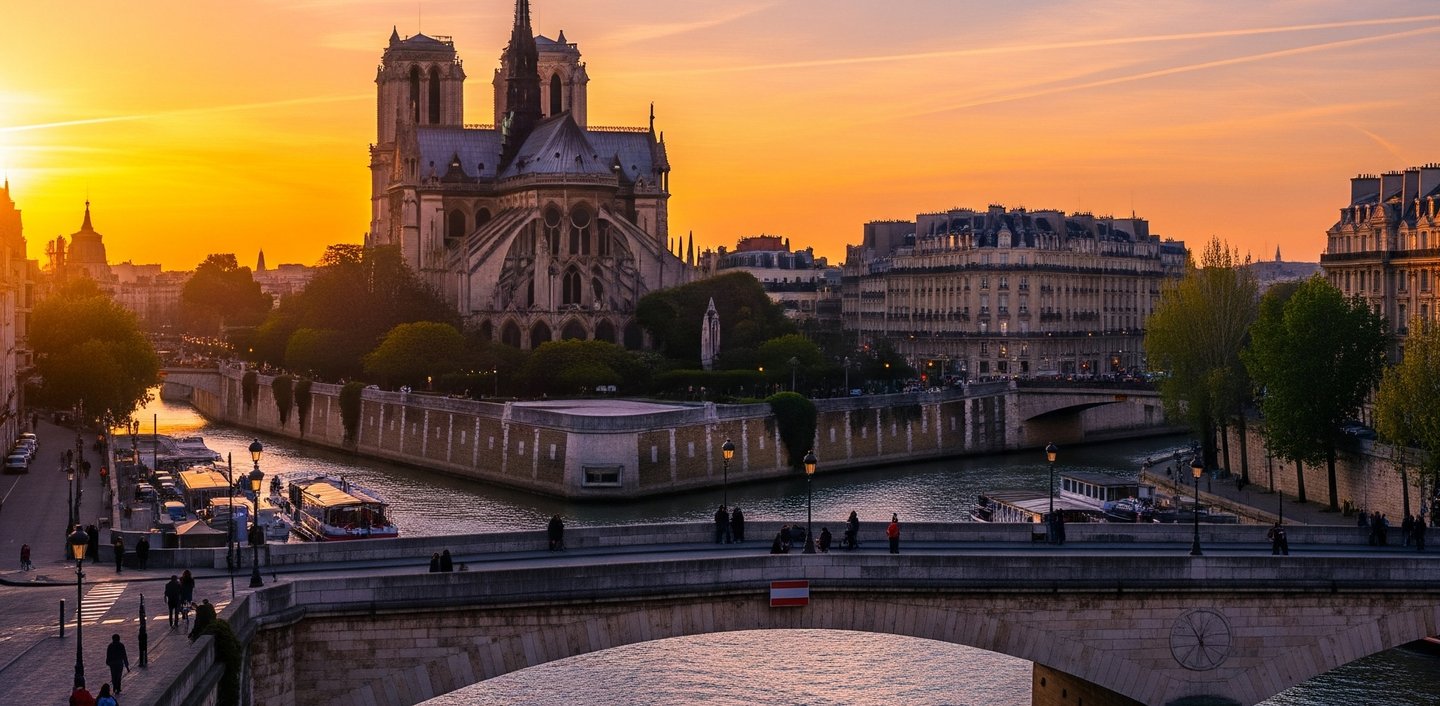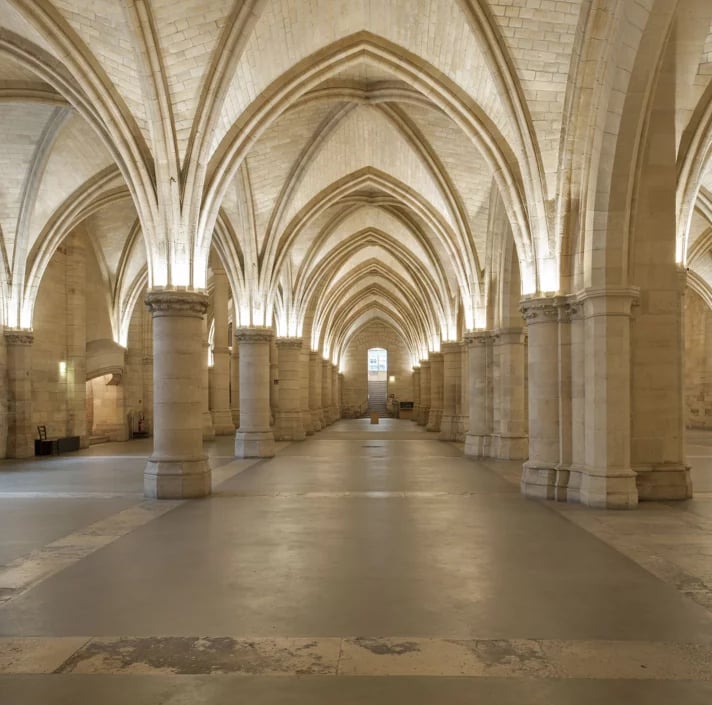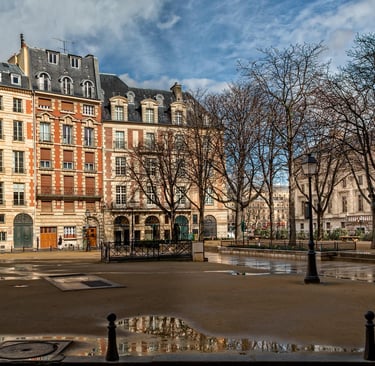
Île de la Cité: A Guide to Notre Dame, Sainte-Chapelle & More
The ultimate guide to Île de la Cité. Discover the history of its iconic landmarks and learn about our expert Notre Dame guided tours, Sainte-Chapelle guided tours, and more.
PARIS GUIDESPARIS HISTORY & LEGENDS
Anchored in the gentle current of the Seine, Île de la Cité is not just a district of Paris—it's the city's very origin story. This ship-shaped island is the literal and figurative ground zero from which Paris grew, serving for over two millennia as the seat of royal power, the center of Christian worship, and the stage for France's most dramatic historical chapters.
To walk its streets is to walk through time itself. But beyond the famous landmarks lies a deeper story of revolution, faith, and reinvention. This in-depth guide will take you beyond the surface, exploring the island's incredible saga from its Celtic beginnings to the present day.
The ancient history of the island, from a Roman fortress to a medieval powerhouse.
What You'll Discover in This Guide
An in-depth look at the "big three" landmarks: Notre Dame, Sainte-Chapelle, and the Conciergerie.
The stories behind the island's smaller, hidden gems and memorials.
Practical tips for planning your visit, including information on our Sainte Chapelle guided tours and Notre Dame guided tours.


To understand the island is to understand Paris itself. Its history is a layered saga of tribes, empires, kings, and revolutionaries, each leaving their mark on this small patch of land.
A Journey Through the Ages of Île de la Cité
The Celtic Origins & Roman Lutetia (c. 3rd Century BC – 4th Century AD)
Before Paris was Paris, it was a settlement called Lutetia, home to a Celtic tribe known as the Parisii. These skilled boatmen and traders controlled the river, but their reign ended in 52 BC when the Romans conquered the region. While the main Roman city grew on the Left Bank (today's Latin Quarter), the island was fortified as the administrative and religious heart. The Romans built two key structures that would define the island's future:
A Governor's Palace (Praetorium): On the western end of the island, a palace was built for the Roman governor. This exact location would later evolve into the medieval Palais de la Cité, the residence of French kings.
A Grand Temple to Jupiter: On the eastern end, a temple dedicated to the supreme Roman god Jupiter was erected. This pagan site was deliberately chosen centuries later for the construction of Notre Dame Cathedral.
The Rise of Christianity & Merovingian Kings (4th – 10th Century)
As the Roman Empire faded, Christianity spread and Lutetia was renamed Paris. Following Germanic invasions, the city's population retreated to the defensible island, which became a sacred center. The pagan temple to Jupiter was torn down and replaced by Christian churches.
The Cathedral of Saint-Étienne: Built in the 6th century, this was the first major Christian cathedral in Paris. For over 500 years, this now-vanished basilica served as the city's main place of worship, the direct predecessor to Notre Dame. Its foundations can be seen today in the Crypte Archéologique.
The Medieval Powerhouse & Royal Splendor (10th – 15th Century)
This was the island's golden age. The Capetian kings made it the undisputed center of French power, transforming it into a dense, bustling medieval city of houses, shops, and numerous small churches.
The Palais de la Cité: The old Roman palace was expanded by a succession of kings into a magnificent royal residence.
Sainte-Chapelle (1248): King Louis IX added this breathtaking "jewel box" Sainte-Chapelle directly into the palace complex to house the Crown of Thorns.
La Conciergerie: As the palace grew, the lower floor, managed by the "Concierge" (the keeper of the palace), became a state prison and judicial center.
Notre Dame Cathedral (1163-1345): The monumental project to replace Saint-Étienne was undertaken, creating the masterpiece of Gothic architecture we know today.
Renaissance, Revolution, and Haussmann's Transformation (16th – Present)
After the royals moved to the Louvre, the island's focus shifted to justice and religion. New landmarks appeared, like the revolutionary Pont Neuf (1607) and the charming residential square Place Dauphine. During the French Revolution, the Conciergerie became the infamous "antechamber to the guillotine."
The biggest change came in the 19th century when Baron Haussmann demolished the island's medieval core, tearing down countless old houses and churches to create the grand administrative buildings and open squares we see today. In the modern era, the island found new purposes, hosting the famous Marché aux Fleurs (Flower Market) and becoming a place of remembrance with the poignant Mémorial des Martyrs de la Déportation at its eastern tip.
A Chilling Legend
The Conciergerie's violent past has left a legacy of spectral residents. To this day, guards and visitors report strange occurrences in its cold corridors. The most famous story is that of Marie Antoinette's ghost, said to haunt the halls near her final cell, a sad echo of the Revolution's tragic final days.

A Deep Dive into the Island's Landmarks
While Île de la Cité is rich with history, three monumental structures tell its most compelling stories: a cathedral that became the soul of a nation, a chapel that became a jewel box for a king, and a palace that became a revolutionary prison.
Notre Dame Cathedral – The Enduring Heart of Paris
More than just a building, Notre Dame is a symbol of resilience. For over 850 years, it has been the spiritual and geographical heart of Paris. Its construction, beginning in 1163, was a monumental feat of Gothic engineering, pioneering the use of flying buttresses to create soaring interiors filled with light. It has hosted royal coronations, survived the French Revolution, and was famously saved from ruin by Victor Hugo's novel. The 2019 fire was just the latest chapter in its long history of surviving turmoil, and its ongoing restoration is a powerful testament to its place in the world's heart.


Sainte-Chapelle – The Jewel Box of Light
Tucked away within the courtyard of the Palais de Justice is Paris's most dazzling treasure. Sainte-Chapelle is a masterpiece of Rayonnant Gothic architecture. Commissioned by the pious King Louis IX and consecrated in 1248 after a miraculous seven-year construction, it was built for a single purpose: to house the most sacred relics in Christendom, including the Crown of Thorns. The upper chapel is where the magic happens; the stone walls seem to dissolve, replaced by 15 towering stained-glass windows that depict over 1,100 biblical scenes in a breathtaking universe of color and light. A Sainte Chapelle guided tour is the best way to understand the epic stories told in this "library of light."


La Conciergerie – From Royal Palace to Revolutionary Prison
The Conciergerie tells a darker, more chilling story. What began as the Palais de la Cité, the luxurious medieval residence of French kings, became one of history's most feared prisons. During the French Revolution, it earned the name "the antechamber to the guillotine." Within its grim, vaulted halls, thousands of prisoners, including the queen, Marie Antoinette, spent their final, terrifying days before being sent to their execution. A tour of the Conciergerie is a powerful journey into the heart of the Reign of Terror.


Beyond the Big Three: Discovering the Island's Charms
While the main monuments rightly draw the crowds, some of Île de la Cité's most profound stories are found in its charming squares, historic bridges, and quiet corners.
Pont Neuf & Place Dauphine
Despite its name meaning "New Bridge," the Pont Neuf (completed in 1607) is ironically the oldest standing bridge across the Seine in Paris. It was a revolution in urban design—the first stone bridge without houses built on it, featuring wide sidewalks for strolling. At its center stands a grand statue of King Henri IV, who also commissioned the charming, triangular square just behind it: Place Dauphine. This hidden gem is one of the most romantic and peaceful spots in Paris, a perfect escape from the nearby crowds.
The Flower Market & a Tribute to a Queen
Known officially as the Marché aux Fleurs Reine Elizabeth II, this delightful Flower Market has been filling the air with the scent of fresh blooms since 1809. Housed in quaint, green pavilions, it's a wonderful place to wander. It was renamed in 2014 to honor Queen Elizabeth II, a noted flower lover, after her final state visit to France.
Mémorial des Martyrs de la Déportation
At the very eastern tip of the island, tucked away in a small park behind Notre Dame, lies one of Paris's most powerful and moving memorials. The Mémorial des Martyrs de la Déportation honors the memory of the 200,000 people who were deported from Vichy France to Nazi concentration camps during World War II. Descending into the stark, subterranean space is a somber and unforgettable experience of remembrance.


Astonishing Facts
The guillotine, a symbol of the French Revolution, had a surprisingly long life. The last execution by guillotine in France took place in 1977—the same year the first Star Wars movie was released and the Centre Pompidou opened in Paris.

How to Make the Most of Your Visit
Now that you know the rich history of Île de la Cité, you're ready to explore it. Here are a few practical tips to help you plan your day.
Practical Tips for Visitors
Best Time to Go: To see Sainte-Chapelle's windows in their full glory, visit on a bright, sunny day. The island is busiest midday, so consider an early morning or late afternoon visit for a more peaceful experience.
Getting There: The Cité metro station (Line 4) drops you right in the middle of the island. You can also easily walk from the large Châtelet or Saint-Michel stations.
Comfort is Key: You will be doing a lot of walking on cobblestones. Comfortable shoes are absolutely essential!
Experience the Stories with a Scenic Zest Tour
Reading about the island is one thing, but experiencing it with a passionate storyteller brings its history to life. Our tours are designed to go beyond the facts and connect you with the soul of Paris.
Notre Dame Exterior & Île de la Cité Tour The story of Notre Dame is best told from the outside, where you can truly appreciate its scale and architectural genius. On this tour, our guides focus on the intricate details of the cathedral's facade, its famous gargoyles, and its incredible story of survival. We bring the "library etched in stone" to life.
Sainte-Chapelle Skip-the-Line Experience: This is the smartest way to visit Paris's dazzling jewel box. Your guide will provide a full, captivating explanation of the chapel's history and the stories within its windows. They will then hand you your pre-booked, skip-the-line ticket, escort you past the long queues to the entrance, and leave you to enjoy a self-guided visit at your own pace, allowing you to marvel at the stained glass without being rushed.
Paris's Darkest Recipe
In the dark medieval alleys of Île de la Cité, on a now-vanished street called Rue des Marmousets, legend tells of a diabolical partnership. It's the original story of Sweeney Todd: a murderous barber and a pastry chef who conspired to turn the barber's victims into highly sought-after meat pies. It's said that their grisly creations became so famous that even King Charles VI enjoyed them before the pair's horrific crimes were finally discovered.

